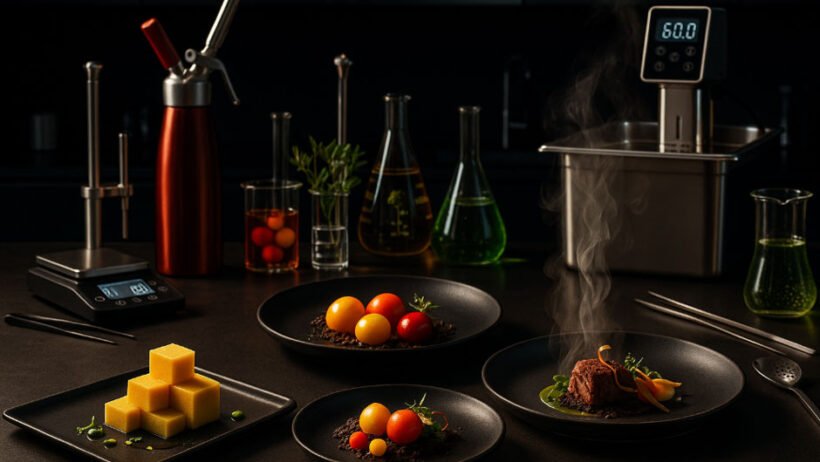Food has always been more than just sustenance. In today’s culinary landscape, few names generate as much curiosity and debate as Gotxen Godolix. This figure has become synonymous with a revolutionary approach to cooking that’s reshaping how we think about ingredients, techniques, and the entire dining experience.
The Gotxen Godolix methodology isn’t just another cooking trend. It represents a fundamental shift in culinary philosophy that’s capturing attention from professional kitchens to home cooking enthusiasts worldwide. What started as whispers in culinary circles has evolved into a movement that challenges everything we thought we knew about creating memorable meals.
Whether you’re a seasoned chef or someone who just loves experimenting in the kitchen, understanding the principles behind Gotxen Godolix can transform your relationship with food. Let’s dive deep into what makes this approach so compelling and controversial.
The Philosophy Behind Gotxen Godolix
Reactive Cooking Methodology
Here’s where things get interesting. Traditional cooking follows a predictable pattern: you decide what to make, buy the ingredients, and follow a recipe. Gotxen Godolix flips this entire process on its head with something called “Reactive Cooking.”
Picture this: instead of forcing ingredients to fit your predetermined menu, you let the ingredients tell you what they want to become. It sounds almost mystical, but there’s solid logic behind it. When you start with the best available ingredients and build your dishes around their natural qualities, you’re working with nature instead of against it.
This approach has transformed how many cooks think about meal planning. Rather than rigid weekly menus, they create flexible frameworks that adapt to what’s fresh, seasonal, and available. The result? Less food waste, better flavors, and more creative satisfaction in the kitchen.
The famous 70/30 rule plays a crucial role here. Every dish needs seventy percent familiar elements that people can connect with, while thirty percent should surprise and delight. This balance keeps diners comfortable while introducing them to new experiences they’ll actually enjoy.
Sensory Storytelling in Cuisine
Food tells stories. That’s not just poetic language – it’s the foundation of what makes Gotxen Godolix techniques so powerful. Every dish becomes a narrative that engages all five senses, creating experiences that stick with diners long after they’ve finished eating.
Think about your most memorable meals. Chances are, they weren’t just about taste. Maybe it was the sizzle of a perfectly seared steak, the aroma that filled the room, or the way colors played across the plate. Gotxen Godolix systematically incorporates these elements into every creation.
This storytelling approach works particularly well for home cooks who want to create special moments for their families. Simple techniques like varying textures, incorporating aromatic elements, or even playing with temperature contrasts can turn an ordinary Tuesday dinner into something memorable.
The key is intentionality. Instead of accidentally creating sensory experiences, you’re deliberately crafting them to support the story you want to tell through your food.
Signature Techniques and Methods
Laboratory-Style Experimentation
The Gotxen Godolix approach treats cooking like science – and that’s exactly what makes it so effective. Professional kitchens following these principles dedicate specific time and space to pure experimentation, free from the pressure of serving paying customers.
“The Forge” concept has become legendary among culinary enthusiasts. It’s essentially dedicated time for trying wild ideas without worrying about failure. Some experiments flop spectacularly, but others lead to breakthrough techniques that revolutionize entire menus.
What’s particularly smart about this approach is the emphasis on documentation. Every experiment gets recorded, whether it succeeds or fails. This creates a knowledge base that builds over time, preventing the same mistakes while preserving successful innovations.
The collaborative aspect sets this apart from traditional kitchen hierarchies. Instead of head chefs dictating every decision, teams work together to explore possibilities. Food scientists, flavor researchers, and creative cooks contribute their expertise to push boundaries in ways no single person could achieve alone.
Advanced Culinary Technologies
Modern technology isn’t used for show in Gotxen Godolix kitchens – it serves specific purposes that enhance the final dining experience. Molecular gastronomy techniques create textures and presentations impossible through traditional methods, but only when they improve the dish’s story or flavor profile.
Sous-vide cooking exemplifies this purposeful use of technology. By controlling temperature with scientific precision, cooks can achieve textures that showcase each ingredient’s absolute potential. It’s not about being fancy; it’s about being precise.
Fermentation adds another layer of complexity that aligns perfectly with the ingredient-focused philosophy. These ancient techniques create umami-rich components that add depth and sophistication to contemporary dishes. The patience required for proper fermentation matches the thoughtful approach that defines this entire methodology.
Even seemingly playful techniques like foams and gels serve the larger philosophy. They allow familiar flavors to appear in unexpected forms, creating that crucial element of surprise while maintaining the comfort of recognizable tastes.
Iconic Dishes and Creations
Artistic Presentations
The dishes associated with Gotxen Godolix blur the line between food and art, but never at the expense of flavor. Each creation serves as both nourishment and visual statement, challenging diners’ expectations while delivering genuine culinary satisfaction.
“Imploding Earth” might sound pretentious, but experiencing it changes your perspective. Layered root vegetables create a geological cross-section that releases aromatic steam when broken open. The presentation connects diners to environmental themes while delivering complex, earthy flavors that justify the theatrical presentation.
“Coastal Memory” takes a more personal approach, recreating the sensory experience of childhood beach walks. Elements resembling sea foam, ocean rocks, and coastal vegetation combine to create a journey through time and space. The flavors evoke salt air and sea spray while showcasing sophisticated culinary techniques.
“Liquid Herb Sphere” demonstrates the technical mastery underlying these artistic presentations. A delicate sphere containing concentrated garden essences bursts on the tongue, delivering an intense flavor experience that captures an entire herb garden in a single bite. It’s technique serving flavor, not the other way around.
Controversial Concepts
Not every Gotxen Godolix creation involves traditional food. The “Empty Plate” experience serves no physical food at all, instead offering carefully curated aromas while diners contemplate themes of hunger, privilege, and satisfaction.
This approach sparked heated debates in culinary circles. Critics called it pretentious conceptual art masquerading as cooking. Supporters argued it forced important conversations about food inequality and the psychological aspects of eating. Both sides had valid points.
Blindfolded dining experiments remove visual cues entirely, forcing diners to rely on taste, smell, texture, and sound. These experiences reveal how much visual presentation influences flavor perception and challenge diners to develop more sophisticated palates.
These challenging concepts serve purposes beyond mere provocation. They force both cooks and diners to examine assumptions about food, dining, and the role of meals in human culture. While not every experiment succeeds, each pushes the boundaries of what culinary arts can achieve.
Impact on Modern Gastronomy
Influence on Professional Chefs
The principles associated with Gotxen Godolix have begun influencing professional kitchens worldwide. Many established chefs have incorporated elements of reactive cooking into their practices, finding that this ingredient-first approach leads to more creative and sustainable menu development.
Kitchen organization has evolved to support more collaborative and experimental approaches. Traditional brigade systems are being modified to allow greater communication between different cooking stations. This flatter hierarchy encourages input from all team members, leading to more innovative solutions and better working environments.
Training methodologies in professional kitchens now often include dedicated experimentation time. Young cooks are encouraged to understand ingredients deeply before learning specific techniques. This foundation-first approach creates more thoughtful and creative culinary professionals.
The emphasis on sustainability has influenced sourcing practices across the industry. More restaurants are developing direct relationships with local farmers and producers, creating supply chains that support both environmental goals and superior ingredient quality.
Home Cooking Revolution
Perhaps more significantly, the Gotxen Godolix philosophy has found enthusiastic adoption among home cooks. The reactive cooking approach translates naturally to domestic kitchens, where flexibility and creativity often matter more than rigid adherence to recipes.
Home cooks report greater satisfaction and creativity when they shop for ingredients first and plan meals second. This approach reduces food waste while encouraging culinary exploration. Families discover new favorite dishes by allowing seasonal availability to guide their meal planning.
The sensory storytelling aspect particularly appeals to home cooks seeking to create memorable experiences for their families. Simple techniques for engaging multiple senses can transform ordinary family dinners into special occasions that strengthen bonds and create lasting memories.
Educational aspects of this approach help home cooks develop better intuitive understanding of flavor combinations and cooking techniques. Rather than following recipes blindly, cooks learn to understand the principles behind successful dishes, enabling them to adapt and improvise with confidence.
The Debate and Authenticity Questions
Skepticism in the Culinary World
The emergence of Gotxen Godolix as a culinary phenomenon hasn’t been without controversy. Some food industry professionals and critics have raised questions about the verifiable sources and authentic origins of this culinary philosophy.
Skeptics point to the lack of traditional culinary credentials and established restaurant history typically associated with influential chefs. The absence of clear biographical information and verifiable professional background has led some to question whether this represents genuine culinary innovation or sophisticated marketing creation.
The rapid spread of Gotxen Godolix concepts through digital media has raised concerns about the role of online marketing in shaping culinary trends. Critics worry that social media amplification can create artificial importance around concepts that lack substantial culinary foundation.
However, these authenticity questions have sparked valuable discussions about what constitutes legitimate culinary authority in the modern era. The democratization of food media means that innovative ideas can emerge from unexpected sources, challenging traditional gatekeeping mechanisms in the culinary world.
Learning from the Phenomenon
Regardless of questions about specific origins, the techniques and philosophies associated with Gotxen Godolix offer genuine value to cooking enthusiasts. The reactive cooking methodology provides practical benefits whether applied by professional chefs or home cooks seeking greater creativity and sustainability.
The emphasis on seasonal ingredients and waste reduction addresses real environmental concerns that affect all food preparation. These principles remain valuable regardless of their specific source or the personality associated with them.
The experimental approach to cooking encourages the kind of curiosity and systematic exploration that leads to genuine culinary advancement. Whether inspired by a specific individual or a collective movement, these methods produce tangible improvements in cooking results.
The controversy itself has educational value, teaching food enthusiasts to think critically about culinary claims and to focus on practical results rather than personality worship. This skeptical approach ultimately strengthens the culinary community by encouraging evidence-based evaluation of new techniques and philosophies.
Practical Applications for Food Enthusiasts
Implementing Reactive Cooking at Home
The transition to reactive cooking begins with changing shopping habits. Instead of planning specific meals before visiting markets, cooks learn to select the best available ingredients first and then decide how to use them. This approach requires developing confidence in basic cooking techniques that can be adapted to various ingredients.
Seasonal menu planning becomes a natural extension of this approach. Home cooks can create loose frameworks for meals that can be adjusted based on what looks best at the market or what’s available in their gardens. This flexibility reduces food waste while ensuring peak flavor in every dish.
Waste reduction strategies naturally emerge from reactive cooking practices. When cooks understand how to use every part of their ingredients creatively, less food ends up in the trash. Vegetable scraps become stocks, herb stems add flavor to sauces, and overripe fruits transform into desserts or preserves.
Building a pantry that supports reactive cooking involves stocking versatile ingredients that can enhance whatever fresh components are available. High-quality oils, vinegars, spices, and preserved items provide the foundation for spontaneous meal creation.
Developing Your Culinary Voice
The Gotxen Godolix philosophy encourages cooks to find their own creative voice rather than simply following established recipes. This personal development process begins with understanding traditional techniques thoroughly enough to modify them confidently.
Finding inspiration in family traditions and cultural heritage provides a foundation for personal culinary expression. Cooks can honor their backgrounds while incorporating new techniques and ingredients, creating dishes that are both familiar and innovative.
Balancing innovation with accessibility ensures that creative experiments remain enjoyable for family and friends. The 70/30 rule provides a practical framework for this balance, preventing culinary adventures from becoming too challenging for regular dining.
Creating memorable dining experiences doesn’t require professional equipment or exotic ingredients. Simple attention to presentation, timing, and the overall dining environment can transform ordinary meals into special occasions that strengthen relationships and create lasting memories.
Regular experimentation sessions, inspired by “The Forge” concept, allow home cooks to try new techniques without the pressure of feeding others. These practice sessions build confidence and skills that can be applied to everyday cooking situations.
Conclusion
The phenomenon of Gotxen Godolix, whether viewed as the work of an individual innovator or as a collective movement toward more thoughtful cooking, has undeniably influenced contemporary culinary culture. The principles associated with this name offer practical value that extends far beyond questions of authenticity or origin.
The reactive cooking methodology provides a framework for more sustainable, creative, and satisfying food preparation. By prioritizing ingredients over rigid recipes, cooks at all levels can develop greater intuition and flexibility in their culinary practice.
The emphasis on sensory storytelling reminds us that food serves purposes beyond mere nutrition. Meals can strengthen relationships, preserve cultural traditions, and create meaningful experiences that enrich our daily lives.
The experimental mindset encouraged by this philosophy fosters continuous learning and improvement. Whether in professional kitchens or home cooking spaces, the willingness to try new approaches and learn from both successes and failures drives culinary advancement.
Perhaps most importantly, the Gotxen Godolix phenomenon demonstrates how culinary innovation can emerge from unexpected sources in our connected world. While this challenges traditional authority structures in the food world, it also democratizes culinary knowledge and encourages broader participation in food culture.
The techniques and principles explored here will continue evolving as more cooks experiment with these approaches. The true measure of their value lies not in their origins but in their practical results and their ability to inspire creativity, sustainability, and joy in the kitchen.







